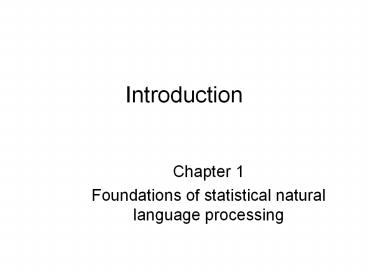Foundations of statistical natural language processing - PowerPoint PPT Presentation
1 / 15
Title: Foundations of statistical natural language processing
1
Introduction
- Chapter 1
- Foundations of statistical natural language
processing
2
NLP and Statistical Approach
- Why many people are adopting a statistical
approach to natural language processing? - How one should approach this approach?
- We will begin with discussion of some
philosophical themes and leading ideas
3
Approaches to language
- Between 1960 and 1985 most of linguistics,
Psychology, Artificial Intelligence and NLP was
dominated by Rationalist approach - Significant part of the knowledge in the human
mind is not derived by the senses but is fixed in
advance, presumably by genetic inheritance
4
Rationalist approach
- Dominated the field due to widespread acceptance
of arguments by Noam Chomsky - Argument Problem of poverty of stimulus
- Difficult to see how children can learn
something complex as natural language from
limited input - Questions?
5
Empiricist Approach
- Also begins with cognitive abilities point
- Difference between approaches is in terms of
degree of belief - Mind does not begin with detailed sets of
principles/procedures for various components of
language and things like morphological structure,
case marking etc. - Babys brain begins with general operations of
associations, pattern recognition, and
generalization
6
- Empiricist approach to NLP suggest that
- We can learn complicated and extensive
language structures by specifying appropriate
general language model - and then using Statistical, Pattern Recognition
and Machine Learning models to a large amount of
language use
7
SNLP
- People cannot work from observing a large amount
of language usage - Instead simple texts are used
- A body of text is called Corpus (pl Corpora)
- Empiricist corpus-based approach is seen in
American Structuralists (Zelling Harris ) - Languages structure can be discovered
automatically using corpus
8
----
- Chomskyan linguistics seeks to describe language
model of human mind (I-language), for which texts
(E-language) provide indirect evidence - Empiricist approaches describe E-language as it
ACTUALLY occurs - Chomsky postulates
- Linguistics competence
- Linguistic performance
9
- Chomskyan linguistics depends on categorical
principles - Do or Do not satisfy
- Same as American Structuralism
- Categorical judgment of rare type of sentences
- Our approach would be inspired of Statistical NLP
draws from work of Shannon - Assign probabilities to linguistic events to
decided which sentences are usual and which are
unusual - Associations and preferences occur in totality of
language use
10
Scientific Content
- Questions that linguistics should answer
- What kind of things do people say?
- What do these things say/ask/request about the
world. - Key point How knowledge of language is acquired
by humans, and how they actually understand and
generate sentences in real time
11
- Competence Grammar
- Said to underlie the language
- Generative approach in speakers head
- It suggests that there is a set of sentences
-Grammatical Sentences- and other strings which
are ungrammatical - The concept of grammaticality
- Judged on how sentence is structurally well
formed - Not according to what people say or semantically
anomalous - e.g. Colorless green ideas sleep furiously
12
- Syntactic grammaticality is a binary choice
- Native speaker normally produces grammatical
sentences - Two points
- Binary choice is plausible for simple sentences
but for complex it may be farfetched - Non native speakers speak something grammatical
but somehow odd. - In addition to this, she insisted that women
were regarded as a different existence from men
unfairly
13
Non-categorical phenomena in language
- Categorical view of language may be sufficient
for many purposes but has its limitations - Frequency based analysis is required
- To see non-categorical phenomena change in the
language should be studied - e.g. While (noun)? time Take a while
- While (Complementizer) While you were out
- After analyzing frequency, category should be
reanalyzed
14
- near Adjective/Preposition
- We will review that decision in the near future
- He lives near the station
- We live nearer the water than you thought
- Grammatically adjectives and nouns do not take
direct object but preposition - convenient for people
- Comparative form is like adjective/adverbs
- Blending and Language change
- Kind of, sort of
- We are kind of hungry
15
Summing up
- Few attempts to use statistical NLP for
explaining complex linguistics phenomena - This new way of looking at language may be able
to account for things such as non categorical
phenomenon and language change - Supportive argument
- human cognition is probabilistic and that
language must be too





![[PDF]❤️DOWNLOAD⚡️ Deep Learning for Natural Language Processing: A Gentle Introduction PowerPoint PPT Presentation](https://s3.amazonaws.com/images.powershow.com/10043728.th0.jpg?_=20240531046)

























